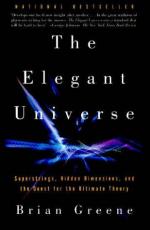
|
| Name: _________________________ | Period: ___________________ |
This test consists of 5 short answer questions, 10 short essay questions, and 1 (of 3) essay topics.
Short Answer Questions
1. In ratios of what number do winding energies come?
2. How many dimensions are necessitated by M-theory?
3. In string theory, how do strings interact?
4. Which of the following will occur after the collapse of the universe as predicted by string theory?
5. Greene suggests that black holes may be elementary particles that have undergone _____.
Short Essay Questions
1. What is the string-coupling constant, and why is it important?
2. What is the horizon problem in cosmology? How was it resolved?
3. What is a wormhole, and how is it formed?
4. Describe the phenomenon of winding in string theory.
5. Greene suggests that black holes are very similar to, and might in fact be, elementary particles. What evidence supports this suggestion?
6. Describe the nature and importance of the procedure discovered by Yau and Tian.
7. What is the relative composition of matter in the universe?
8. Describe the state of the universe's expansion, including what its ultimate fate might be.
9. What is the major problem preventing string theory from gaining widespread acceptance, and why does this problem persist?
10. Describe the entire process of a conifold transition.
Essay Topics
Write an essay for ONE of the following topics:
Essay Topic 1
Black Holes Redux
String theory provides some tantalizing possibilities for explaining the nature of black holes. These incredibly powerful cosmic objects were part of the reason that string theory was created in the first place. Their incredible extremes have been the point that most other theories get off the train, but string theory is able to handle these problems deftly. Part 1) Why can string theory analyze black holes where other theories fail? Include a discussion of quantum mechanics, general relativity, and entropy as they relate to this subject.
Part 2) String theory predicts the possibility of dramatic tears in space-time called conifold transitions. Explain what these events are and how they relate to the formation and structure of black holes.
Part 3) Explain the theory that black holes and elementary particles are different phases of the same material. Explain what phase-transition is and how this concept relates to black holes. If true, what are the implications of this concept?
Essay Topic 2
Inflation
Inflation theory is a very unusual theory about the first moments of the universe's existence. It predicts that an unimaginably massive expansion took place in a mind-bogglingly short period. However, the theory has been more or less definitively confirmed, and is an important part of modern cosmology.
Part 1) Describe the nature of the microwave cosmic background radiation and the horizon problem. Fully explain how these things relate to the expansion of the universe and the classic model of the big bang.
Part 2) Explain the development of inflation theory. How does it solve the horizon problem?
Part 3) How is the inflation theory affected by string theory?
Part 4) Explain some of the effects of the inflationary period on the universe that we observe today.
Essay Topic 3
The Most Famous Equation
Einstein's famous equation, E=mc^2 was not actually published in his original papers on relativity. It was a minor note in a clarification written later, but its importance was instantly recognized. Today, it is the most famous and recognizable equation in the world, and is used almost as a garnish to any depiction of scientific work. This essay is about the discovery and applications of this famous equation.
Part 1) What does the equation mean? What does each component represent, and what is the underlying principle that the equation embodies?
Part 2) How was this equation discovered? Explain in detail how it is related to general relativity and how it indicates that no object with mass can move at exactly the speed of light.
Part 3) Explain some of the implications of this equation. How can its effects be observed in everyday life? How would our world be different if we were ignorant of this equation?
|
This section contains 1,231 words (approx. 5 pages at 300 words per page) |

|




